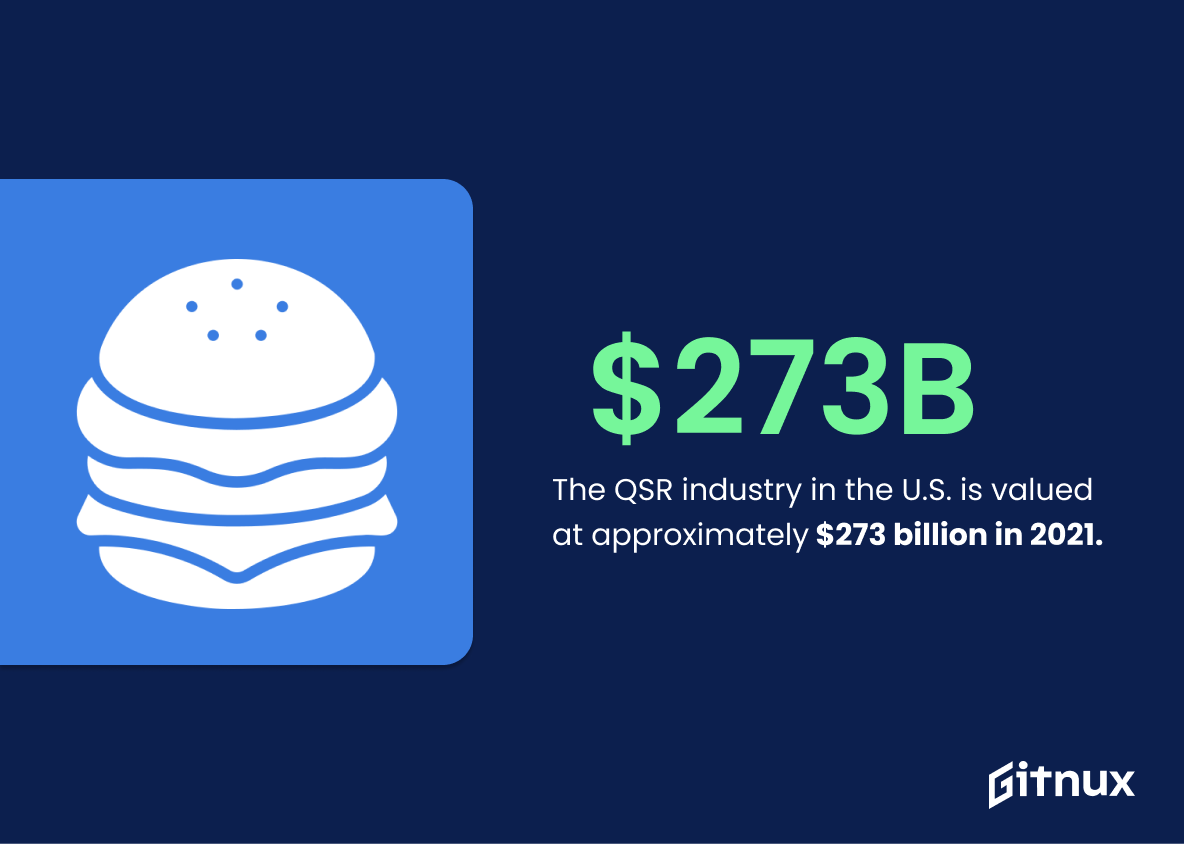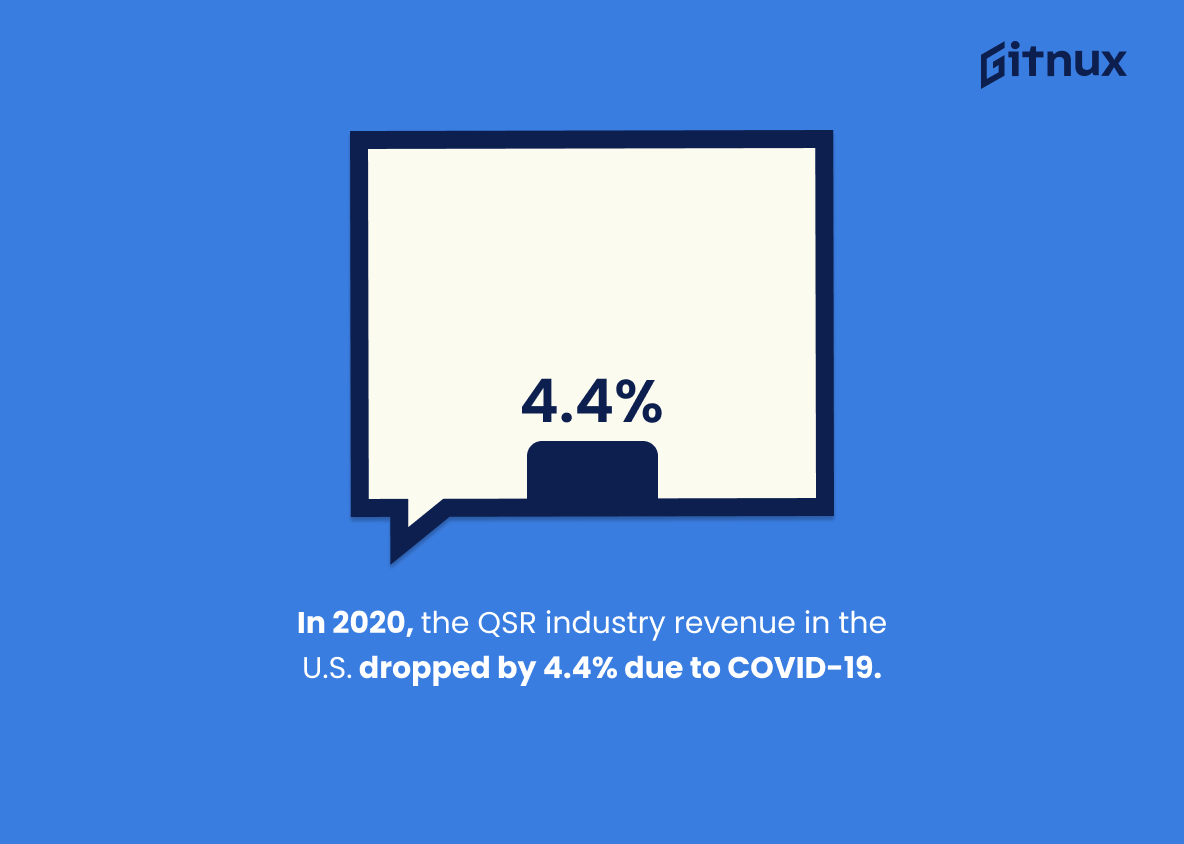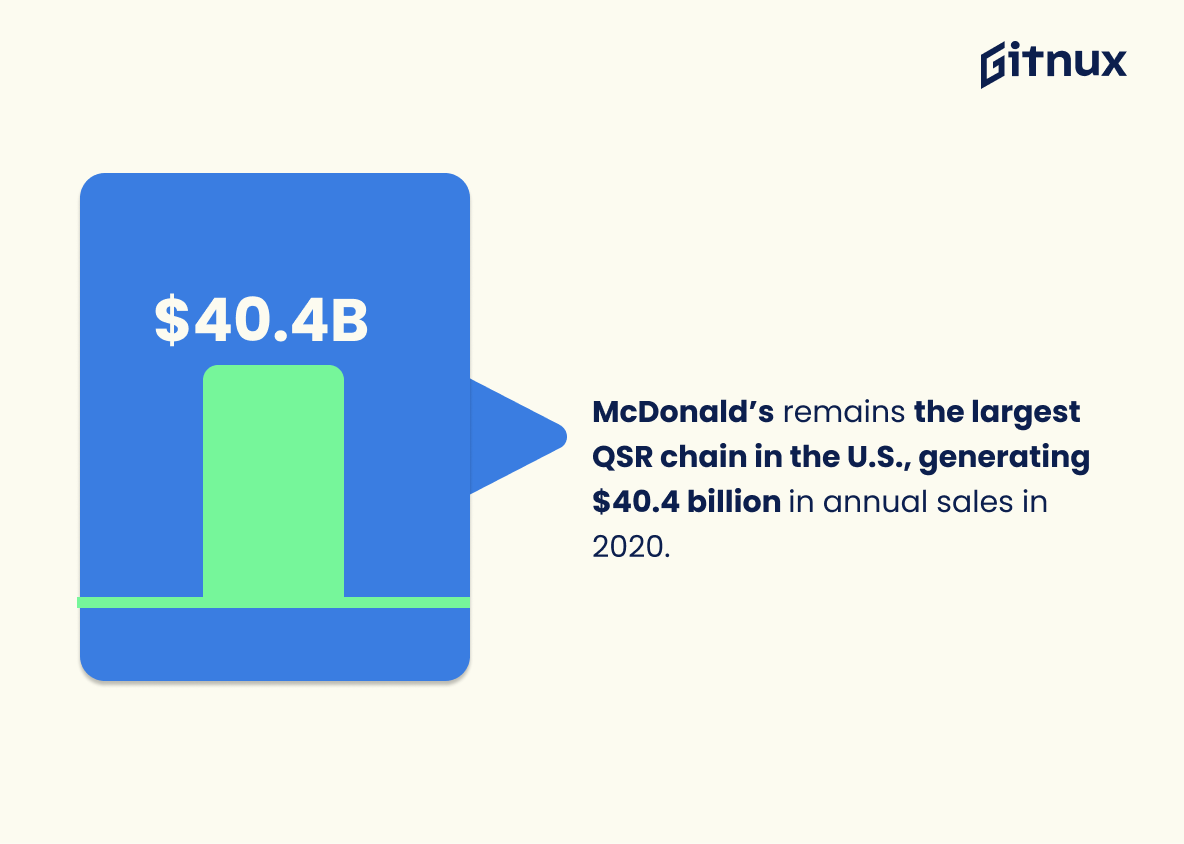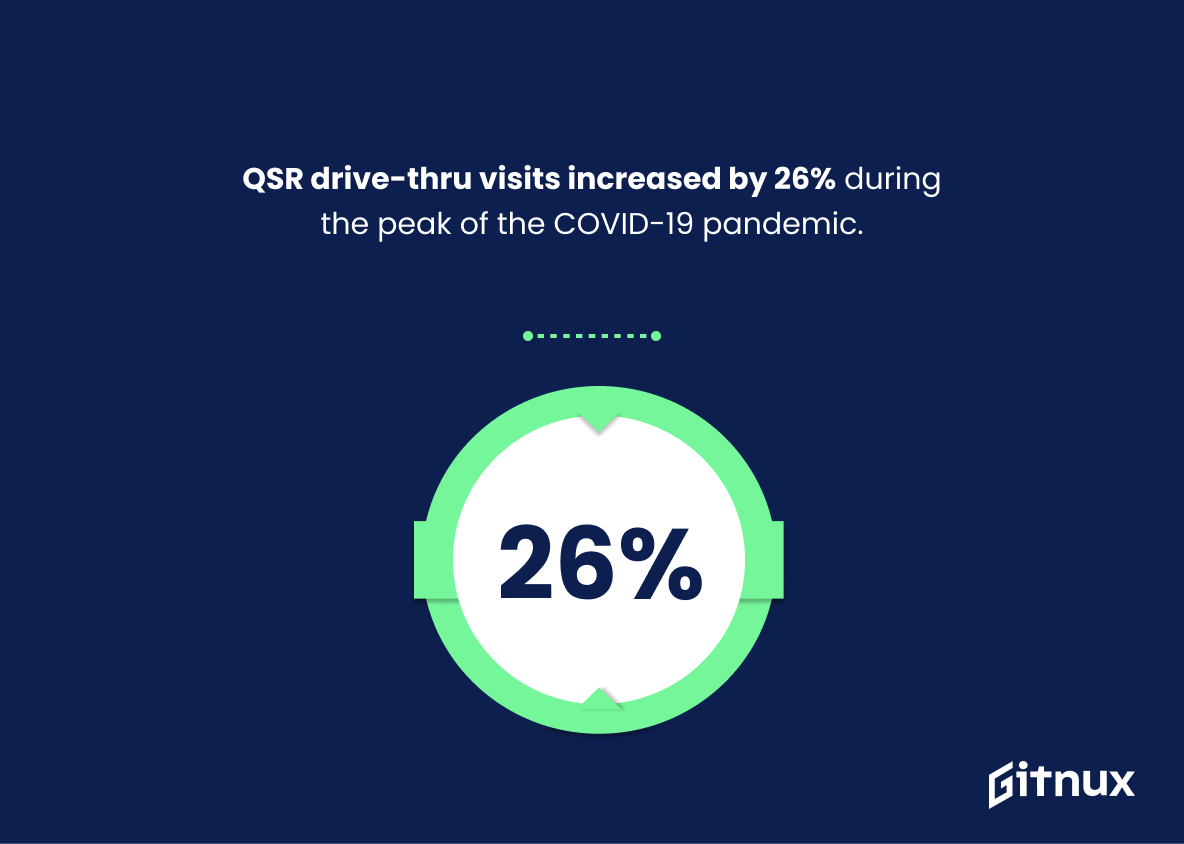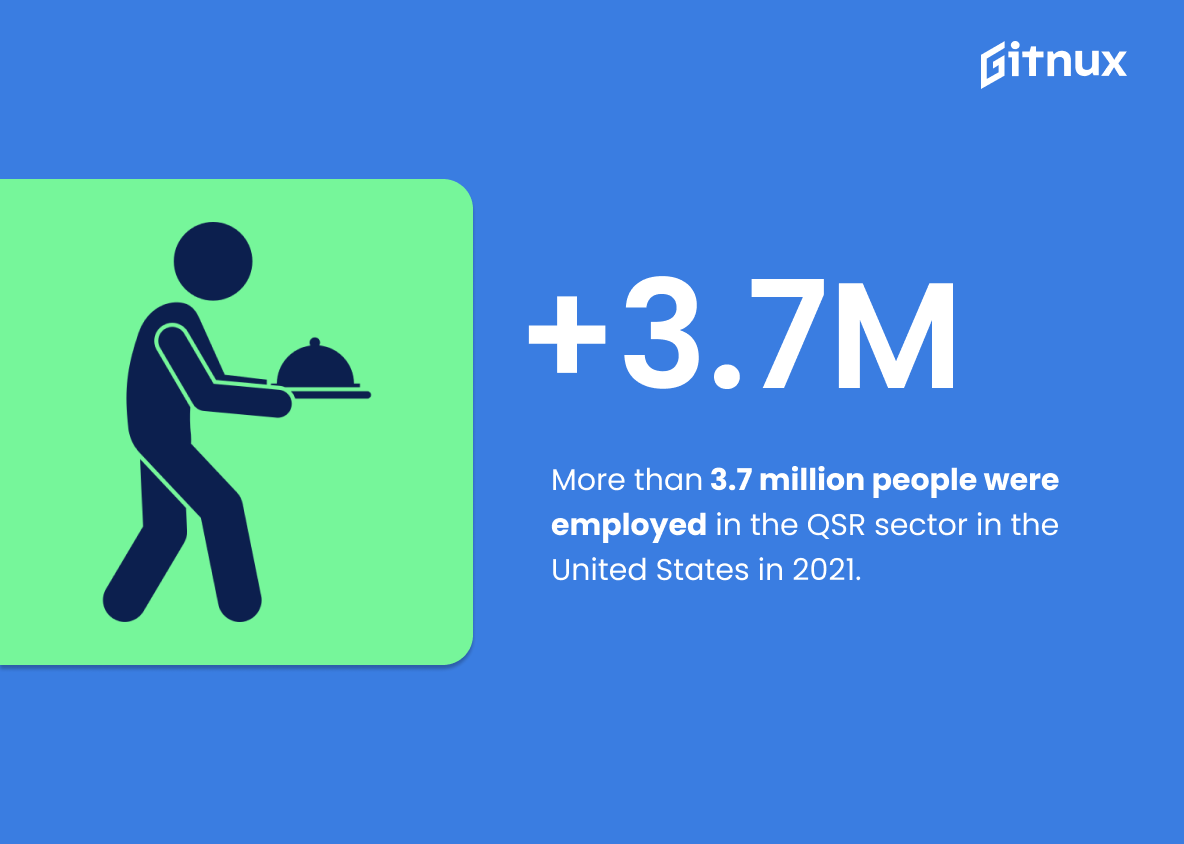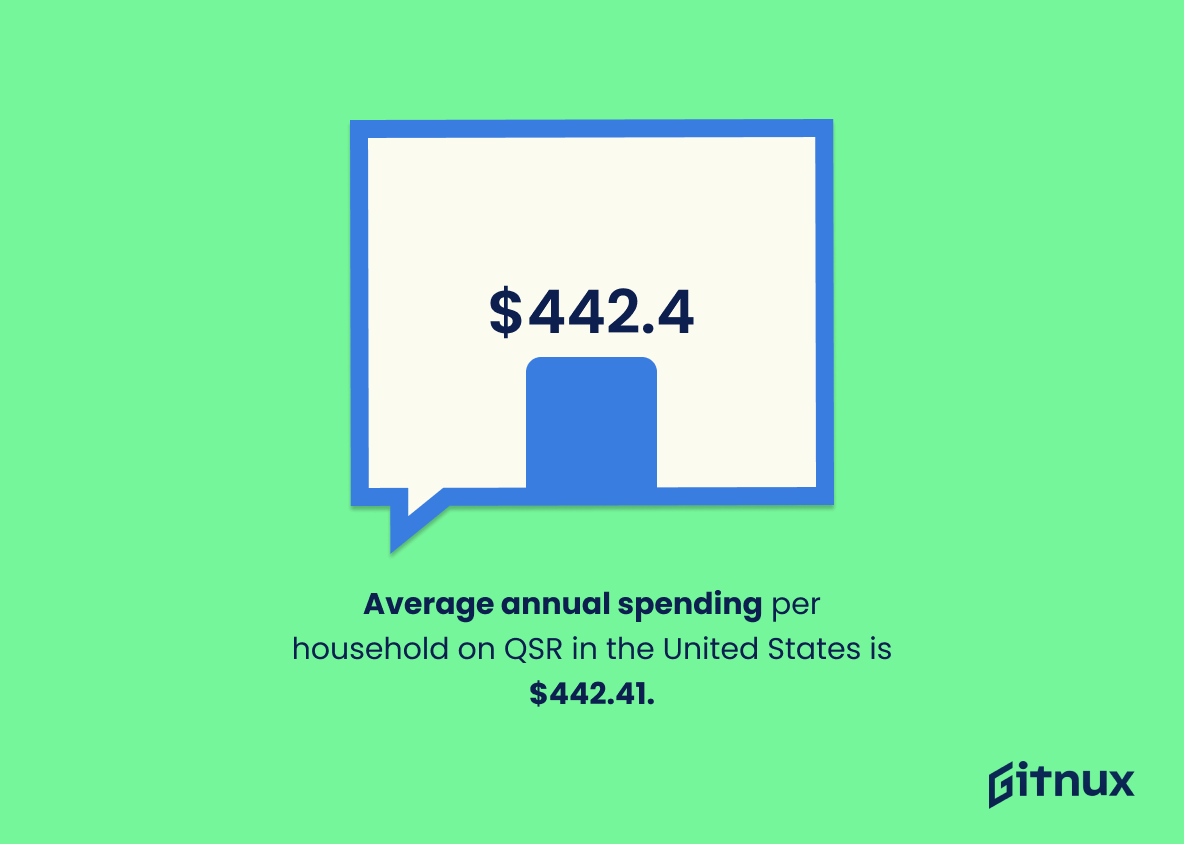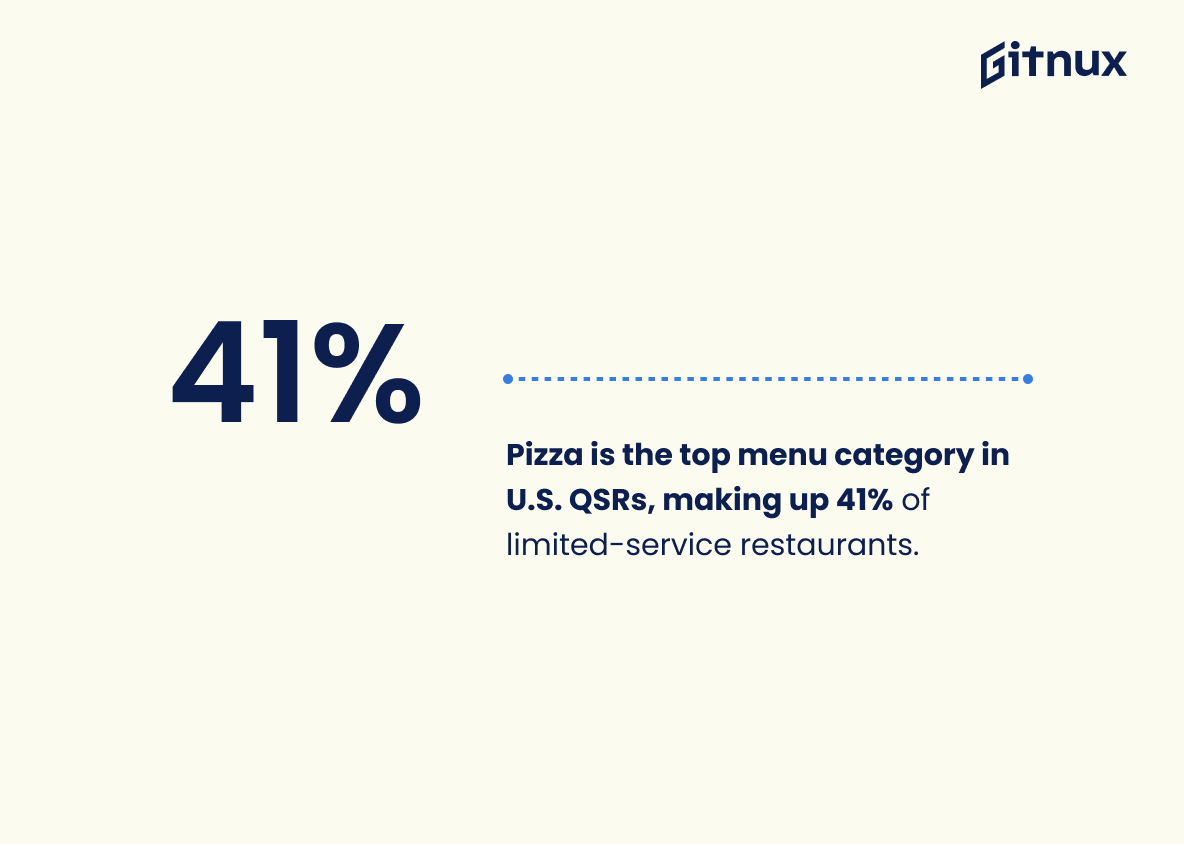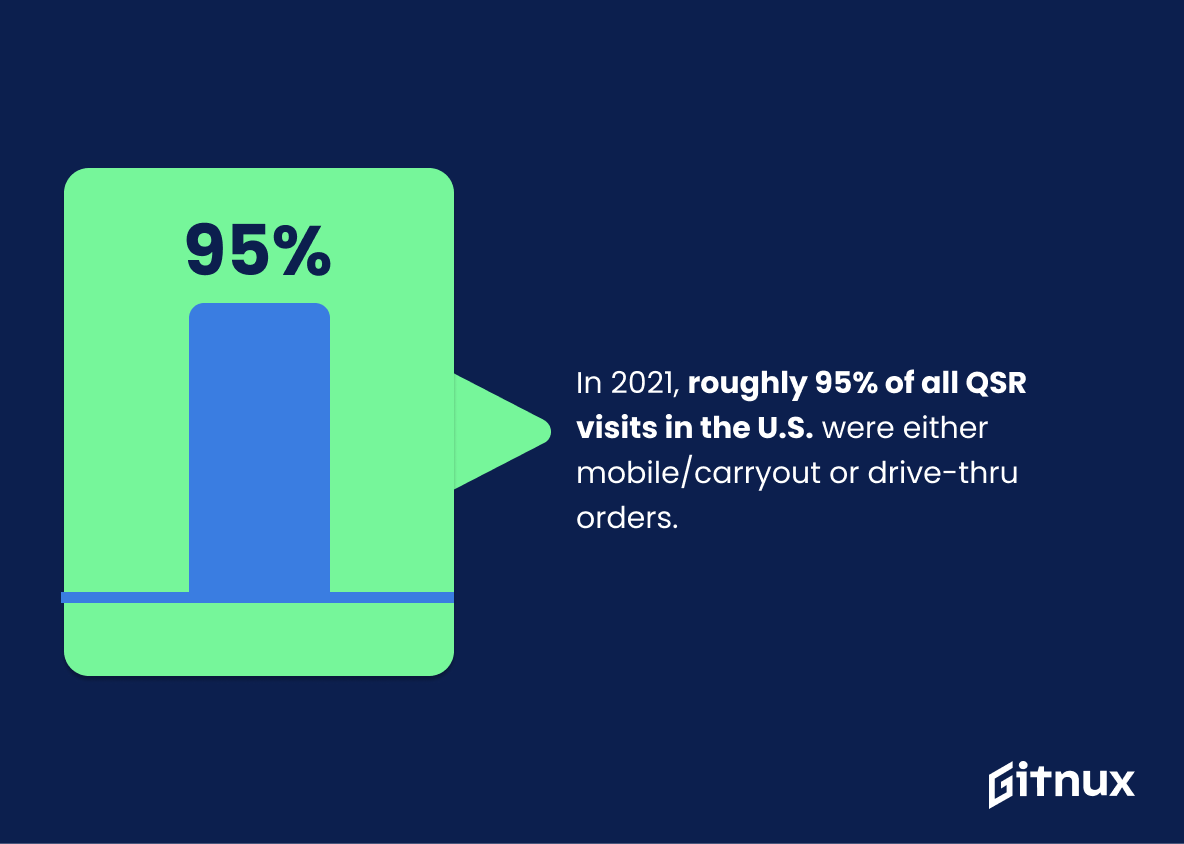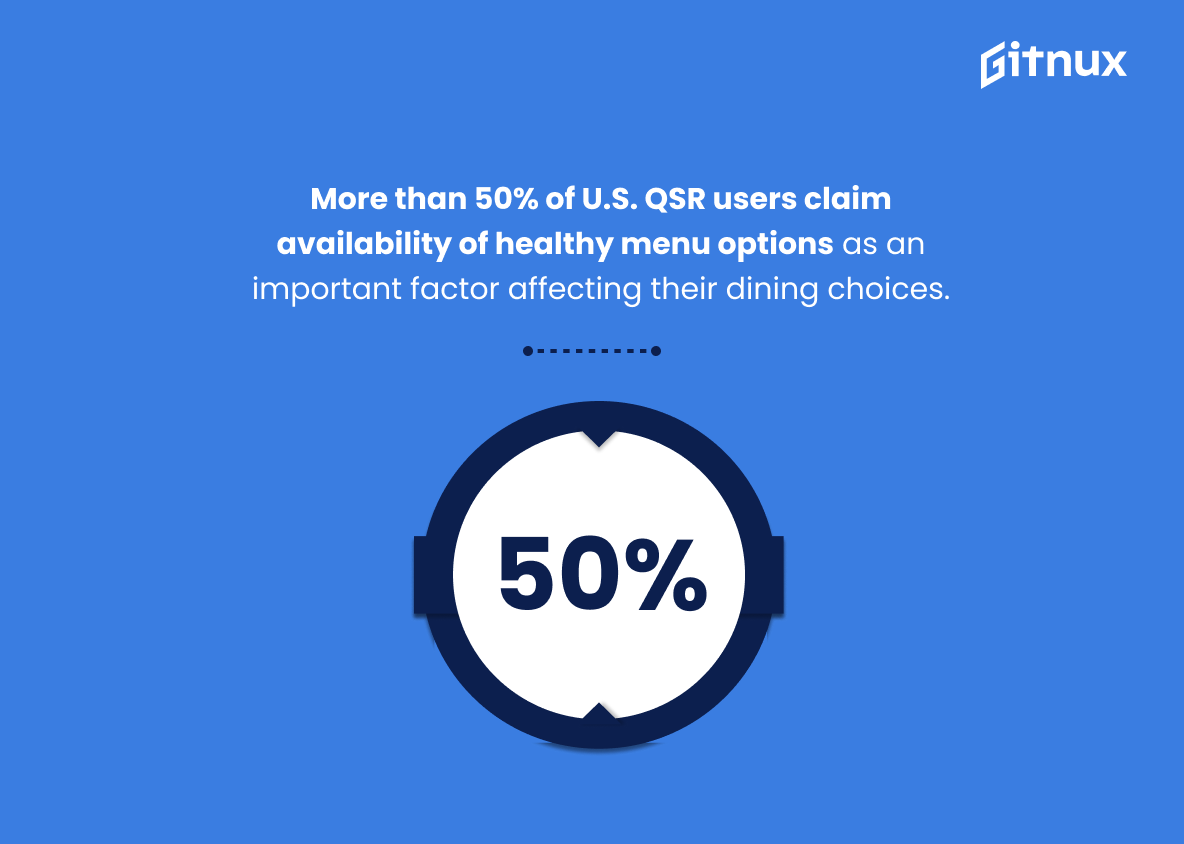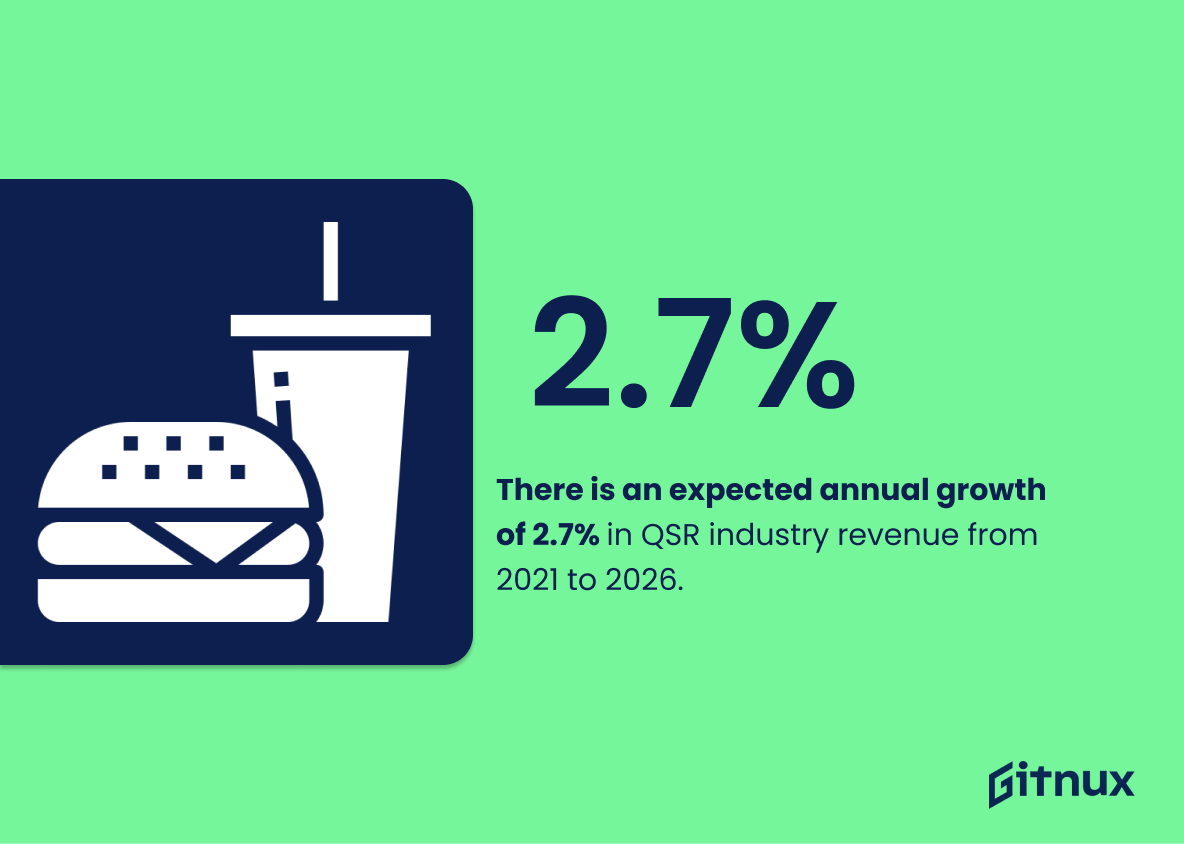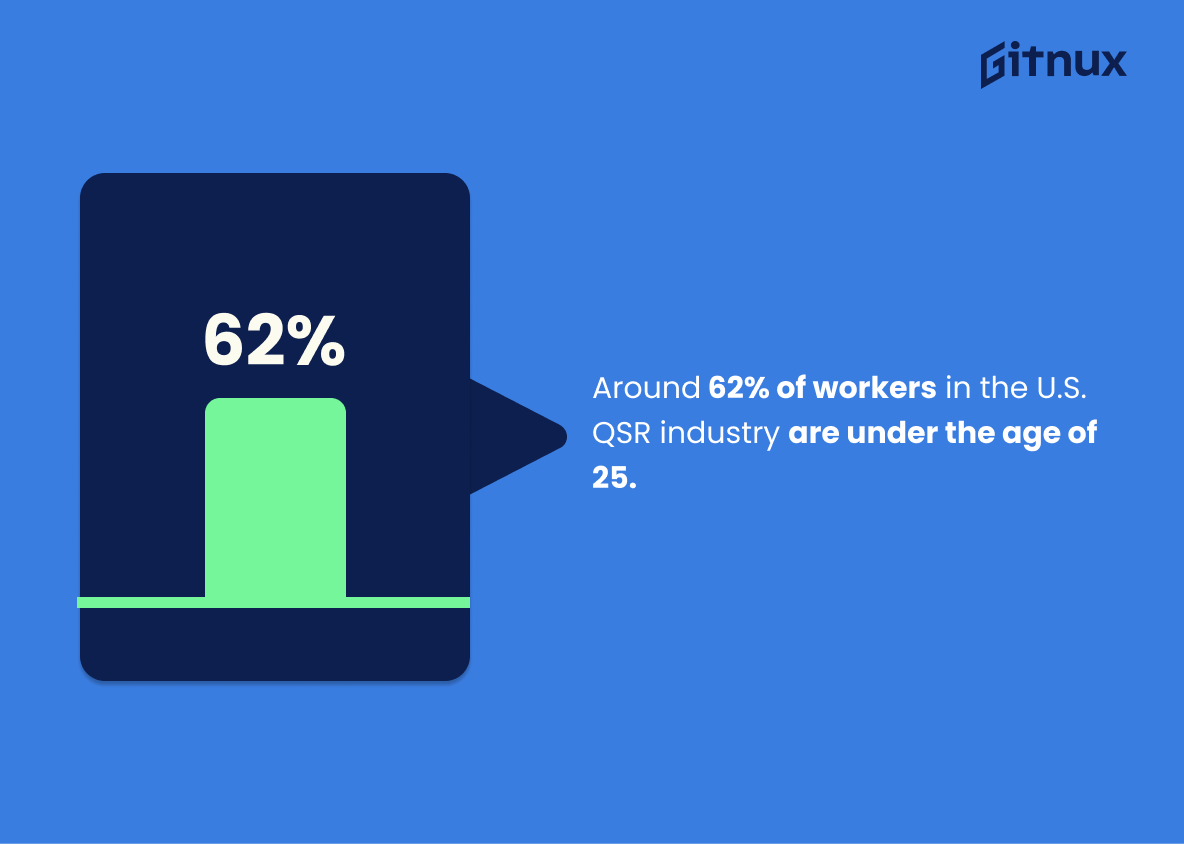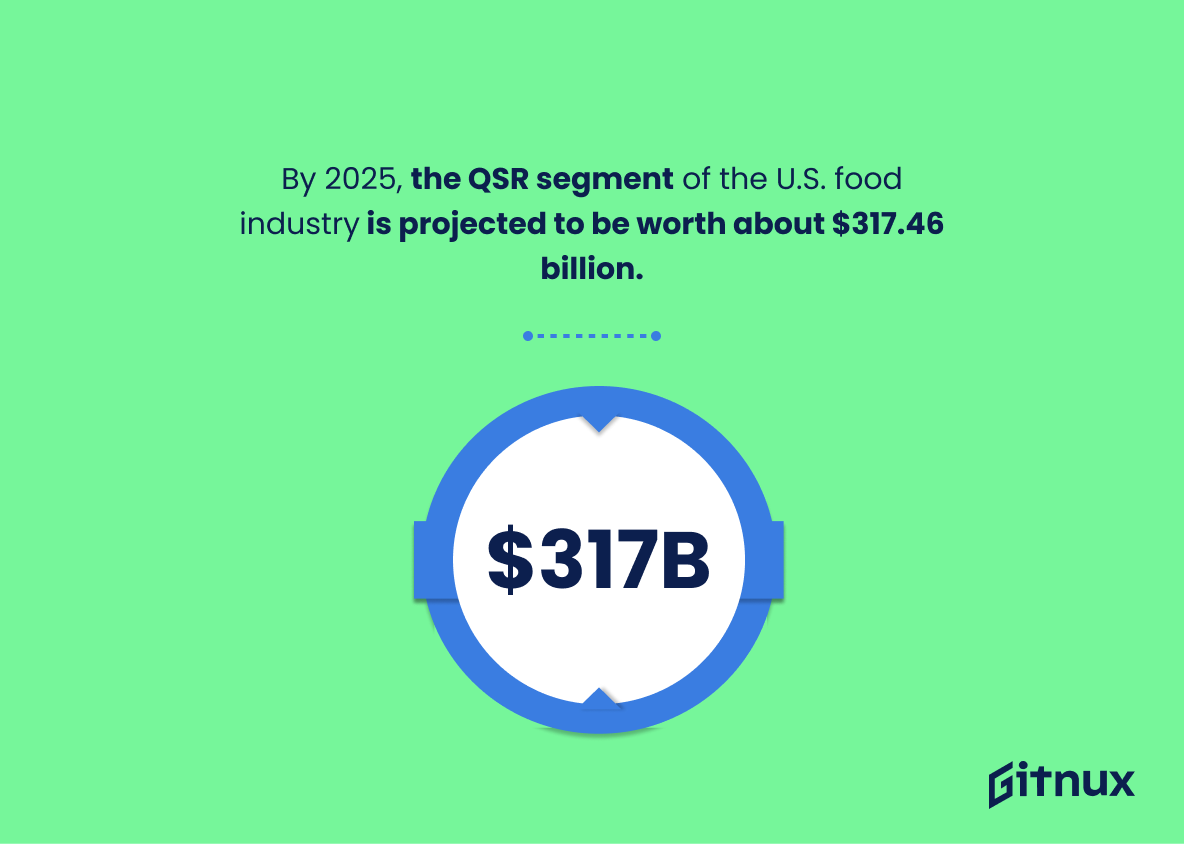The QSR industry in the United States is a rapidly growing sector, with an estimated value of $273 billion in 2021. Despite the economic downturn caused by COVID-19, there are still over 725,000 QSR units operating across the country and McDonald’s remains its largest chain with annual sales of $40.4 billion. During 2020, drive-thru visits increased significantly due to pandemic restrictions and now account for 44% of all fast food restaurant visits. Additionally, more than 3.7 million people were employed in this sector last year and average spending per household on QSRs was around $442 annually.
Pizza is currently the most popular menu category among U.S.-based quick service restaurants (QSRs), accounting for 41% of limited-service establishments while 95% of all orders placed at these locations are either mobile/carryout or drive-thru orders according to recent data from 2021 surveys conducted by NRN & Statista respectively . Furthermore, availability of healthy options has become increasingly important when it comes to dining choices as 50+ percent consumers claim that they take into consideration before deciding where to eat out; however despite this trend profits margins remain between 6%-9%. The market share held by QSR segment within US foodservice industry stands at 53%, which is expected grow further up till 2025 reaching 317$ Billion mark along with 2 % growth rate yearly during same period.. Moreover 70 %of total qsr’s present In USA belong To franchisees , making them major players In Industry . Lastly Average wait times have also seen increase Of 7 9 % From 2019 -2020
Qsr In The Us Statistics Overview
As of 2021, there are over 725,000 QSR units operating in the United States.
This statistic is a testament to the immense popularity of QSRs in the United States. It shows that the QSR industry is thriving and that it is a major part of the American economy. It also indicates that the demand for QSRs is high, which means that there is a great opportunity for businesses to capitalize on this trend. Furthermore, this statistic provides insight into the size and scope of the QSR industry, which can be used to inform decisions about marketing, operations, and other aspects of the business.
McDonald’s remains the largest QSR chain in the U.S., generating $40.4 billion in annual sales in 2020.
This statistic is a testament to McDonald’s enduring success in the QSR industry, highlighting the company’s ability to remain the top chain in the U.S. despite the ever-changing landscape of the industry. It is a powerful reminder of the company’s strength and resilience, and serves as a benchmark for other QSR chains to strive for.
QSR drive-thru visits increased by 26% during the peak of the COVID-19 pandemic.
This statistic is a testament to the resilience of the QSR industry during the peak of the COVID-19 pandemic. Despite the challenges posed by the pandemic, QSR drive-thru visits still managed to increase by a significant 26%, demonstrating the industry’s ability to adapt and thrive in difficult times. This is an important statistic to consider when discussing QSR in the US statistics, as it highlights the industry’s strength and potential for growth.
More than 3.7 million people were employed in the QSR sector in the United States in 2021.
This statistic is a testament to the immense growth of the QSR sector in the United States. It shows that the sector is thriving and that more and more people are finding employment in this field. This is an important indicator of the health of the economy and the success of the QSR industry.
Average annual spending per household on QSR in the United States is $442.41.
This statistic is a telling indication of the popularity of QSRs in the United States. It shows that, on average, households are willing to invest a significant amount of money in QSRs, demonstrating the widespread appeal of this type of food. This statistic is an important piece of information for anyone looking to gain a better understanding of the QSR industry in the US.
Pizza is the most popular menu category in U.S. QSRs, accounting for 41% of limited-service restaurants.
This statistic is a powerful indicator of the importance of pizza in the QSR industry in the US. It demonstrates that pizza is the most sought-after item on the menu, and that it is a major driver of business for limited-service restaurants. This information is essential for anyone looking to gain insight into the US QSR industry, as it provides a clear picture of the most popular menu items and the impact they have on the industry.
In 2021, roughly 95% of all QSR visits in the U.S. were either mobile/carryout or drive-thru orders.
This statistic is a telling indication of the current state of QSRs in the US. It shows that the majority of customers are opting for convenience over traditional in-store dining, which speaks to the changing landscape of the industry. This statistic is important to consider when discussing QSRs in the US, as it provides insight into the current trends and preferences of customers.
More than 50% of U.S. QSR users claim availability of healthy menu options as an important factor affecting their dining choices.
This statistic is a powerful indicator of the importance of healthy menu options in the QSR industry. It shows that consumers are increasingly looking for healthier options when dining out, and that QSRs need to take this into account when designing their menus. This is especially relevant in the context of a blog post about QSR in the US statistics, as it provides insight into the current trends and preferences of US consumers.
There is an expected annual growth of 2.7% in QSR industry revenue from 2021 to 2026.
This statistic is a crucial indicator of the potential for success in the QSR industry. It shows that the industry is expected to grow steadily over the next five years, indicating that now is a great time to invest in the QSR industry. This statistic is a key piece of information for anyone looking to gain insight into the QSR industry in the US and make informed decisions about their investments.
The average profit margin for a QSR in the United States is between 6% to 9%.
This statistic is an important indicator of the financial health of QSRs in the United States. It provides insight into the profitability of the industry, and can be used to compare the performance of different QSRs. Additionally, it can be used to inform decisions about pricing, marketing, and other strategies that can help QSRs maximize their profits. As such, this statistic is a valuable piece of information for anyone interested in the QSR industry in the United States.
QSRs in the United States experience a yearly turnover rate of 130%, with the industry average being 73%.
This statistic is a telling indication of the state of QSRs in the United States. It reveals that the turnover rate for QSRs is significantly higher than the industry average, suggesting that there are underlying issues that need to be addressed. This could be anything from inadequate wages to a lack of job satisfaction, and it is important to understand the root causes of this high turnover rate in order to ensure the success of QSRs in the US.
Around 62% of workers in the U.S. QSR industry are under the age of 25.
This statistic is significant in understanding the QSR industry in the US, as it highlights the prevalence of young workers in the sector. It is important to note that the majority of employees in the QSR industry are under the age of 25, as this could have implications for the industry’s labor practices, wages, and job security. Additionally, this statistic could be used to inform policy decisions related to the QSR industry, such as the implementation of minimum wage laws or the enforcement of labor laws. Furthermore, this statistic could be used to inform marketing and recruitment strategies for the QSR industry, as it provides insight into the demographic of the industry’s workforce.
By 2025, the QSR segment of the U.S. food industry is projected to be worth about $317.46 billion.
This statistic is a testament to the immense potential of the QSR segment of the U.S. food industry. It shows that the industry is expected to grow significantly over the next few years, and that it is an attractive investment opportunity for businesses and entrepreneurs. This makes it an important topic for discussion in a blog post about QSR in the US statistics.
There was a 7.9% increase in average QSR drive-thru wait times from 2019 to 2020.
This statistic is a telling indication of the impact the pandemic has had on QSRs in the US. It highlights the fact that, despite the challenges of the past year, QSRs have had to adapt to the changing landscape and find ways to keep up with the increased demand. This statistic is a testament to the resilience of the QSR industry and the hard work of its employees.
The QSR segment accounts for 53.3% of the total market share for the U.S. foodservice industry.
This statistic is a powerful indicator of the immense influence the QSR segment has on the U.S. foodservice industry. It demonstrates that the QSR segment is a major player in the industry, and its success is essential for the overall success of the industry. This statistic is an important reminder of the importance of the QSR segment in the U.S. foodservice industry and should be taken into consideration when discussing QSR in the US statistics.
Conclusion
The QSR industry in the United States is a rapidly growing sector, with an estimated value of $273 billion in 2021. Despite the economic downturn caused by COVID-19, revenue for this sector dropped only 4.4% and there are now over 725,000 units operating across the country. McDonald’s remains at the top of this market with annual sales totaling $40.4 billion while drive-thru visits increased significantly during 2020 due to pandemic restrictions on dining out. The average household spends around $442 per year on QSRs and pizza is still one of its most popular menu categories accounting for 41%. With more than 3 million people employed in this field and expected growth rates reaching 2.7%, it’s clear that quick service restaurants will continue to be a major part of our economy going forward into 2025 when they are projected to reach nearly $317 billion dollars worth as a segment within foodservice industry overall which accounts for 53% share among all other segments combined .
References
0. – https://www.grandviewresearch.com
1. – https://www.nrn.com
2. – https://www.profitventures.co
3. – https://www.ibisworld.com
4. – https://www.bls.gov
5. – https://www.restaurantbusinessonline.com
6. – https://www.mckinsey.com
7. – https://www.technomic.com
8. – https://www.qsrmagazine.com
9. – https://www.restaurant.org
10. – https://www.statista.com
